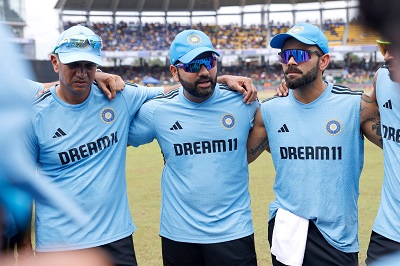Chennai, (Samajweekly) When the 2011 Men’s ODI World Cup happened, there was huge excitement about the twists and turns happening in a one-day game, culminating in MS Dhoni slamming the most unforgettable six in the history of the format for making India win the trophy in Mumbai.
But 12 years down the line, the one-day format finds itself on a sticky wicket. The T20 format, then still in its infancy days, has now become the ruler of minds of cricket enthusiasts, mostly amongst youngsters, mainly through its proliferation in franchise leagues.
Though the 2023 Men’s ODI World Cup is up and running in India, the lack of spectators in the opener between England and New Zealand at Ahmedabad has set off a fresh debate over the future of the format. Rahul Dravid, the India head coach with 344 ODI caps, wishes to see the format thrive and do well even if its future looks tense.
“We haven’t played a lot of 50-overs cricket in the last bit, which is something I have noticed in the couple of years I have been in coaching the team. One I feel is that there were two T20 World Cups that happened back-to-back and there’s always a World Test Championship at the back of everything you are doing; it’s just a constant cycle of whatever you are doing.”
“Can’t exactly say, but maybe because of Covid-19, it has just felt like we haven’t played a lot of one-day cricket yet. Even when we played one-day cricket, we kind of prioritized other things and for managing as well as protecting our players, maybe we have used this format,” said Dravid in a press conference at MA Chidambaram Stadium on Friday.
He also gave the example of fast-bowler Mohammed Siraj’s terrific seven-over spell of 6-21 in the Asia Cup final against Sri Lanka, and eloquently said on how ODIs made watching that performance possible, as well as of Devon Conway and Rachin Ravindra smashing centuries in New Zealand’s opening win of the World Cup over England.
“Going forward, it’s a really important format as it’s a fantastic format to play. How much of it to be played will be decided by a variety of factors and with more T20 matches being added to the calendar, it will make it difficult to potentially have a number of one-day games that you probably have had between 2015-19 cycle.”
“We can’t go back to those days, but we can sincerely hope that we still keep valuing and playing this format. Like, the Siraj spell in Asia Cup final – that was six overs of top-class bowling. It’s something you would never see in a T20 game and on a good day, he could have bowled maybe three overs, not more than that.”
“But here you got to see a full gamut of his skills and abilities, which I think one-day cricket allows you to do that – it allows you to see really good spells and watch really good innings, like the ones from those two left-handers (Devon Conway and Rachin Ravindra). It allows you to see good spin, rotation of strike, and creativity as well. As a coach and someone who loves game of cricket, I would love to see this format thrive and do well.”
With India set to travel a whopping 8,400 km in 34 days of playing league stage matches, Dravid chose to see the bright side of it, instead of viewing it as a source of exhaustion. “When you were asking this, I was thinking from inside that how much exciting it is to travel to nine cities and hopefully for eleven cities (in the knockouts).”
“Playing in front of our home crowd and showing them our skillsets, I see this as a very exciting opportunity to play in the competition. Like, many fans have some of our players as their favourites and seeing them in action in person in various cities is a chance to spread a festival of happiness.”









